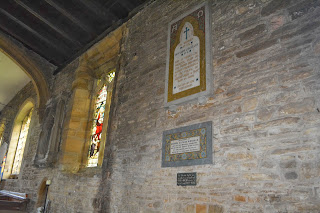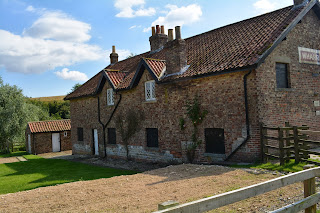Truth be told, I left
Wharram Percy a little conflicted. The day, in some respects, had been a frustration; two locked churches, a confounding journey to the medieval village, shrieking kids running around and spiking my Keats-channeling vibe at the church.
Well, it's all part of being off the beaten path, I told myself - you get what you get, and if you want a controlled, predictable tourist experience, stick to the museums and the bus tours.
Kirkham Priory was next.
 |
| Kirkham Priory |
Founded in 1130 by
Walter l'Espec,
according to wiki "a prominent military and judicial figure of the reign of
Henry I of England...", Kirkham was the first of three religious missions credited to l'Espec, the others being
Rievaulx Abbey further north in Yorkshire and
Wardon Abbey in Bedfordshire. Kirkham was founded first, as an
Augustinian monastery, while the somewhat grander mission at Rievaulx came a few years later, as l'Espec became enamored of the recently imported
Cistercian order, and there was evidently a bit of tension between the two houses.
Abbeys were basically little corporations - they held land, produced food and goods, vied for favor from the royalty and nobility, and sustained themselves through local manpower and markets for their goods. Priories, for the sake of brevity, were their branch offices. As a whole, they were in all useful respects money makers. (When Henry VIII dissolved the monasteries in the 1530's, he first assumed control of all houses that were worth less than
£200 per annum, which was actually a lot of money for the time, before coming to his senses and realizing that he could just take the rest too. Which he did.) Reivaulx' land holdings came uncomfortably close to Kirkham's, and the rise of the Cistercian order in Yorkshire must have made the Kirkham canons feeling a bit like l'Espec's first ex-wife.
Like virtually all the great monastic ruins in Britain, Kirkham is managed by
English Heritage, and it was our first opportunity to buy our two week overseas visitor's pass. (Wharram Percy was also a Heritage site, but they don't charge admission.)
We were just about the only ones there, and the place was an elixir.
 |
| Kirkham Priory |
 |
| Kirkham Priory |
The warm afternoon sun followed us around the place, the great church arch peering down at the stubby remains of the nave.
There were a couple of
in situ tombs, and some mason-graffiti.
 |
| Kirkham Priory- tombs |
 |
| Kirkham Priory- tombs |
 |
| Kirkham Priory - Mason's grafitti |
Churchill visited this place during the planning for D-Day - they tested some of the landing craft here, for reasons unknown to either of us.
A second tier monastic ruin (if you count Rievaulx,
Fountains and
Glastonbury as the Top Three), Kirkham was exactly what our spirits needed, glowing with that intangible psychic gravity unique to ancient and ruined monastic sites. Our only regrets about the place were that we couldn't spend more time there, and that both of us were a bit worn down by all the walking we did at Wharram Percy. We spent a good twenty minutes chatting with Miss Jones in the admission office/gift shop, she gave us a couple of recommendations for old churches in the area, we bought the book, and we took off.
On the way out to the car, the sun was just positioning itself for a terrific side-light angle on the 13th century gatehouse. I actually made Sharon wait as the shadows doggedly crept their way across the sculptured renderings of St Philip, St Bartholomew
 |
| Gatehouse - Kirkham Priory |
and, of course, St George slaying a dragon.
 |
| Fie, ye evile beaste ! - Kirkham Priory |
It may the greatest medieval gatehouse we'd ever seen, which now that I think about it, is a pretty weird superlative.
The Day That Never Ended drew us next to
Sheriff Hutton, a murmur of a village just north of York. We found this by mutual and oddly synchronous accident; Sharon was doing her little-towns-on-Google-maps church fishing thing, while I had found references to a privately held castle there, a walk-roundable ruin that looked sumptuously creepy. It was close enough to York
that we added the place, and Sharon had plotted the day so that we'd hit it on the way back to town.
Built around 1100, barely a generation after the
Conquest, the church is dedicated to St Helen and the Holy Cross, and looks every bit its 900 year age, having undergone little of the Victorian restoration efforts so commonly found in ancient English churches. The place was surprisingly unlocked; dark and somber inside, almost airless.
 |
| St Helen and the Holy Cross, Sheriff Hutton |
 |
| St Helen and the Holy Cross, Sheriff Hutton |
 |
| St Helen and the Holy Cross, Sheriff Hutton |
 |
| St Helen and the Holy Cross, Sheriff Hutton |
At the northeastern corner, near the chancel, lay two effigy tombs; the smaller of the two allegedly contains the mortal remains of Edward, Prince of Wales, son of
Richard III, who died at age 11 in 1484 at nearby
Middleham Castle, Richard's Yorkshire stronghold and site of his own boyhood.
 |
| Edward, Prince of Wales (?) - St Helen and the Holy Cross, Sheriff Hutton |
It is said that this is the only member of British royalty buried at a parish church in the entirety of Britain (his father, of course, was
found just last year under a parking lot in Leicester).While elaborately carved, something about the tomb just didn't
feel like that of a prince, and there is some dispute over whether or not this is really Edward's tomb.
While there is no doubt that Richard's young son died in 1484, no one can be really certain if he ended up here - the monument itself is not engraved with a name.
It is said that Richard had planned a grander tomb for Edward at the
Minster in York, but his defeat at the hands of
Henry VII the following year left Edward at this tiny church, in a stately but temporary tomb, his royal bloodline effectively revoked with the rise of the Tudors, who undoubtedly had little interest in memorializing the despised and defeated
Plantagenets. Wiki
tells us that some historians now believe the effigy is that of a child of the local nobility.
 |
| Sir Edmund Thweng, d.1344 - St Helen and the Holy Cross, Sheriff Hutton |
The other effigy, next to Edward (or whoever it is), is that of Sir Edmund Thweng, a highly esteemed baron of the 14th century, about who we wouldn't presume to say much.
These folks have some (somewhat dense)
biographical information on the man. He died in 1344, making this effigy a century older than the child's. Suitably costumed for a nobleman in repose, Sir Edmund rests his feet upon his dog, who may or may not be in there with him. (In the interests of full disclosure, Sharon thinks it's a lion, in which case it is certainly NOT in there with Sir Edmund.)
 |
| Sir Edmund's dog (or a lion) - St Helen and Holy Cross, Sheriff Hutton |
This place left us energized, almost breathless. Positively one of the best parish churches we've seen in the country. We shot the cemetery on our way back to the car, Sharon fired off a couple of shots of the castle on our way out of town.
 |
| Sheriff Hutton Castle |
And lastly, in the fading evening light, we stopped off at
Whenby and St Martin's Church (built circa 1400).
 |
| St Martin's Church - Wenby |
One of a small handful of
Churches Conservation Trust properties we hit on this trip, St Martin's sits atop a little hill, and as we approached the church door, a small herd of suddenly startled black-faced sheep rushed forward to the fence along the pathway, barking and bleating and cooing at us in agitated unison. (Yes, sheep bark, or at least these sheep did.)
 |
| 'ello, lads ! - St Martin's Church, Wenby |
The first thing I thought was, ok, this is a CCT property, it probably doesn't get many visitors and the sheep just want a little attention. Before we could properly introduce ourselves, they wobbled back to the long grass at the back of the churchyard, turning and watching us with skepticism.
 |
| OK, never mind - St Martin's Church, Wenby |
Sheep in the churchyard. OK.
We shot the church - spare, humble, rescued from oblivion like so many other redundant churches by the tender mercies of the CCT - and caught a few shots of the churchyard and its detachment of skittish woolly guardians (and a lonely pig, 'round back).
 |
| Not a sheep, and I don't bark - St Martin's Church, Wenby |
Back to York and the hotel. The Buzzard Sisters were predictably planted in the garden; they asked about our day and I didn't have the energy to manage more than "It was great". We washed up and headed into town for dinner. Thomas's had closed their kitchen, so we went down a few doors to the Pizza Express and noshed on some over-priced, thin crust pizza next to a family with two bored-looking teens.
This was a good day.



















































